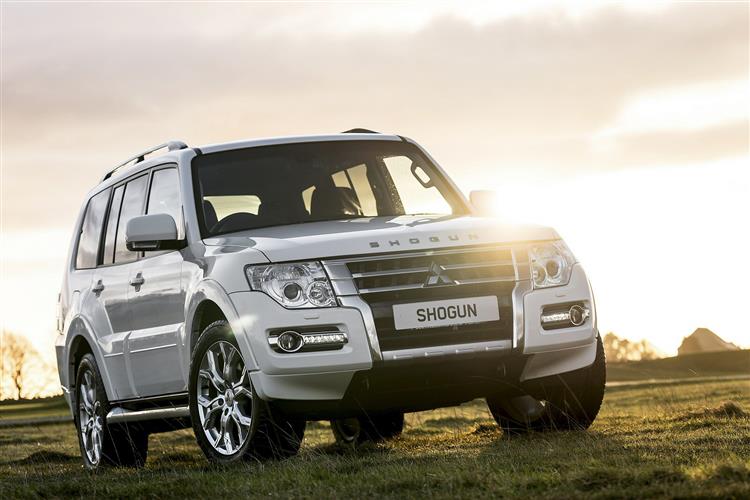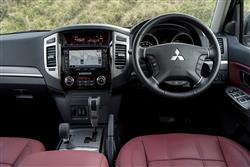AUTHENTIC TO THE CORE (some text hidden) --NONE--
By Jonathan Crouch
Introductionword count: 121
Not all large, luxurious family-sized 4x4s have to be pretend off-roaders, really more tarmac-orientated. Here's a five or seven-seater contender that really can cut it when the going gets rough and has a proper 4x4 heritage with a badge you can trust in this sector. This fourth generation Mitsubishi Shogun offers loads of space, decent value for money and an unstoppable feel and we look at it here in the improved form which launched in 2012 and formed the basis for the car which continued to sell until 2019. Though a Shogun can't match the road-going prowess and interior class of German large SUV rivals, it's more practical than any of them. Authentic, capable and very tough, it'll probably out-last you.
Modelsword count: 7
5dr SUV - SWB & LWB (3.2)
Historyword count: 259
Mitsubishi likes to see its Shogun as the 'original' large 4x4, an SUV tough enough to venture where others feared to tread, yet offering the interior luxury of a high-end saloon. Back in 1982 when it was first launched, it was the only real option for those unwilling to stretch up to a Range Rover and sold in prodigious numbers until the Nineties arrived along with a host of new rivals, nearly all prioritising a smoother roadgoing experience. It took until the new millennium for the Shogun to make any real attempt to sharpen up its act on tarmac and even then, it continued to buck the luxury 4x4 trend by prioritising ultimate go-anywhere ability over ultimate road going response. As the decade wore on, comparisons with luxury 4x4 models like BMW's X5, Mercedes' M-Class and Audi's Q7 seemed more and more irrelevant. This was something different, like Toyota's Land Cruiser a really 'authentic' large SUV designed for people who actually wanted to fully exercise its rugged virtues. People living in remote areas. People who wanted to tow. People who wanted more than just a lifestyle statement. These folk knew what they were getting with a Shogun, but there weren't enough of them. Hence Mitsubishi's continual attempts to do what it could to broaden this model's appeal, most notably with a far-reaching package of improvements in 2012 which gave the car a sharper look inside and out and, most importantly, a more efficient Euro V-compliant engine. A further update was made in 2015 and sales finally ended in 2019.
What You Getword count: 429
Though the front end of this MK4 model gained a minor spruce-up in 2012 (and again in 2015) with a smarter grille and colour-keyed front bumper, the shape remains instantly familiar, the short overhangs, the upright windscreen, the strong high flanks, the flared wheelarches and the rear-mounted spare wheel all combining to remind buyers that this is no bling smoothie, instead wearing its credentials on its sleeve. Mitsubishi remained one of the few brands to offer a three-door short wheelbase body style in this market sector, but that remained a minority choice, most Shogun customers preferring the five-door long wheelbase shape. It's a properly big machine, nearly 5m long and nearly 2m in both width and height, so you'll need a hefty garage with a fair amount of headroom, especially if you fit a roof box for ski trips. The benefit of those huge dimensions is realised when you want to fill the car up with people. Unlike the way many large luxury 4x4s squeeze in a third seating row, this one accommodates it with ease, using an innovative 'Hide&Seat' system that folds the rearmost bench out of the floor. It's a pity though that you don't get two separate chairs so that when you're six-up, you can keep one folded and still have a modicom of boot space. As it is, there is of course very little with all the seats in use. Fold the third row though and a long wheelbase Shogun affords you 1790-litres of fresh air - and even more of course should you be able to flatten the middle bench as well. Short wheelbase Shogun customers get a 1120-litre boot. Getting to the rearmost seats will be a fairly straightforward process for all but the elderly. And once there, you've enough space and floorplan height to ensure that you don't need to sit with knees up around your ears. The middle seat is comfortable for a couple of fully-sized adults - but much less so for three. Which leaves the driving position, where the design changed little since we first saw the 4th generation Shogun back in 2007. So don't expect much in terms of soft-touch plastics and luxury-car-like erognomics. Mitsubishi subsequently did its best to smarten things up with better quality upholstery, nicer instrument illumination and a brushed silver finish around the power window switches on the doors. On a plush variant, you also get lashings of leather (which is nice) and artificial wood inserts (less so). Ultimately though, what really matters is that it all feels like it's been built to last.
To see the full road test text contact us on 0330 0020 227
Pictures (high res disabled)

.jpg)
|
.jpg)
|
.jpg)
| |||
.jpg)
|
.jpg)
|
.jpg)
| |||
.jpg)
|

|
Scoring (subset of scores)
Category: Crossover or SUV 4x4s
| Performance | |
| Handling | |
| Comfort | |
| Space | |
| Styling, Build, Value, Equipment, Depreciation, Handling, Insurance and Total scores are available with our full data feed. | |



